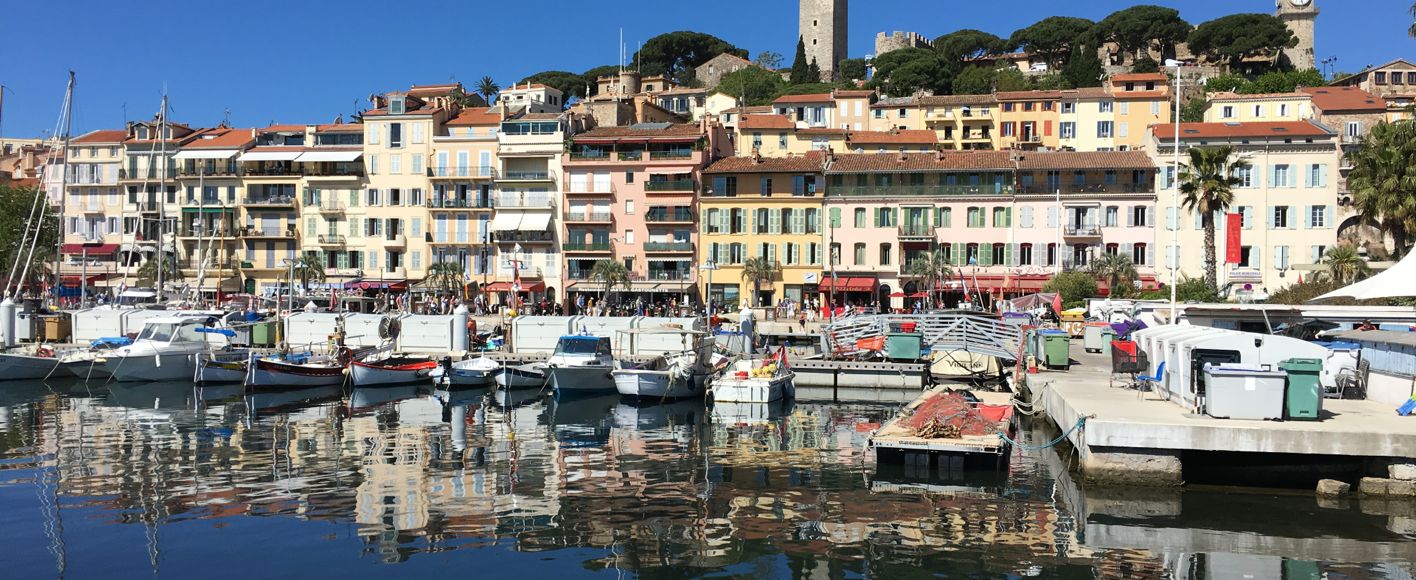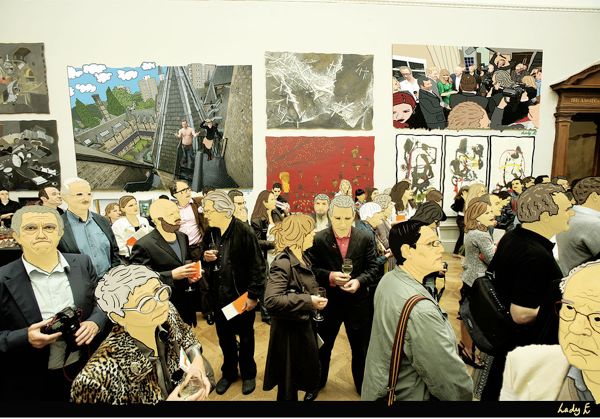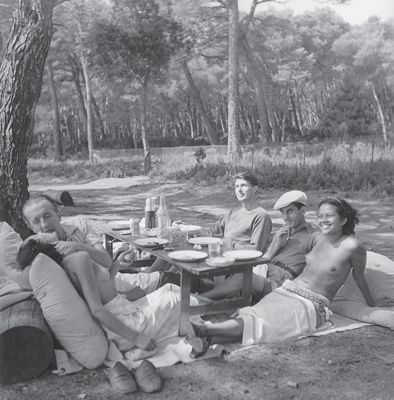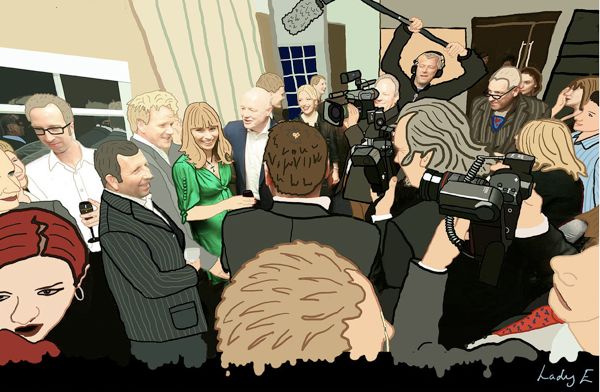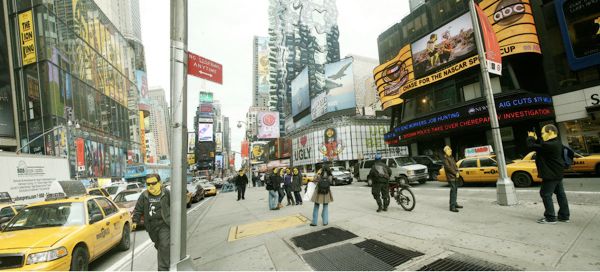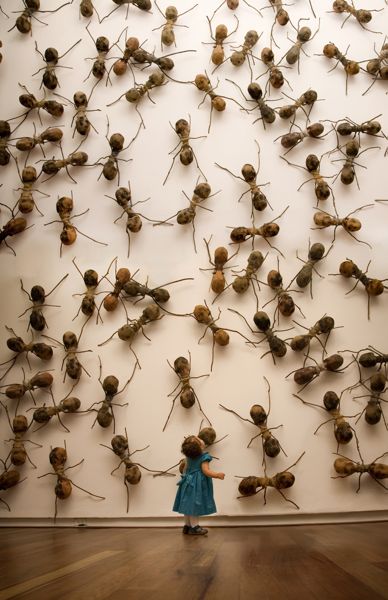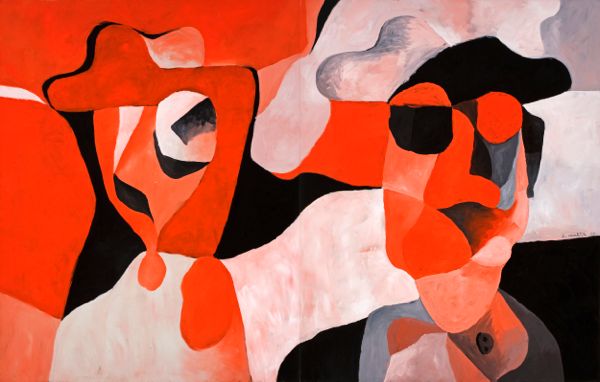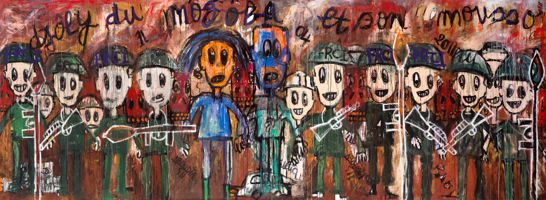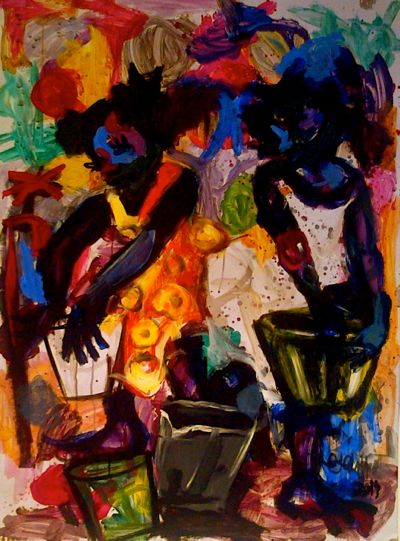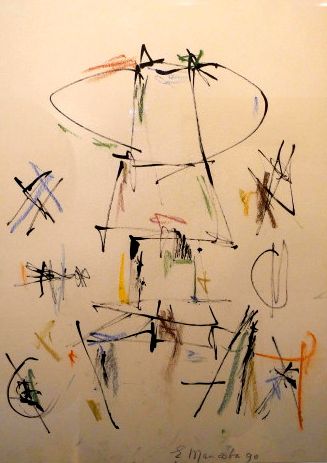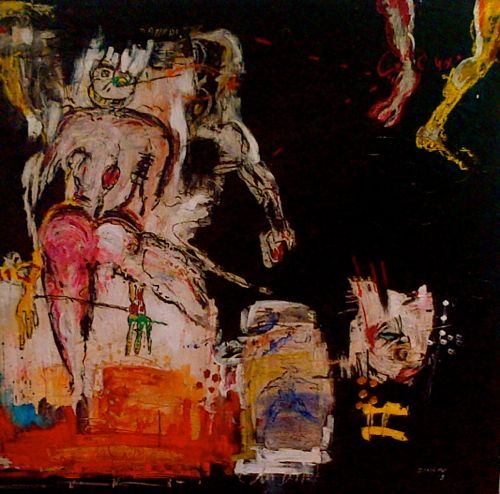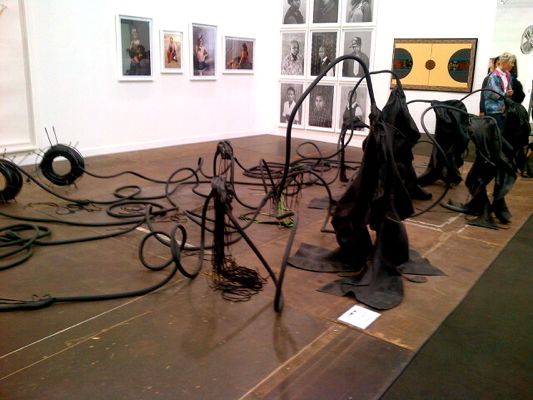 Demystifying The Art World
Demystifying The Art World
Images 1-4
1 Yellow Faces ( RA Summer Show, 2008 by ELF )
Making art, living art, breathing art, or at least that was the dream. Becoming an artist hasn’t been what I expected. I bought into the fantasy that art was somehow a way to live and be free. That art was about expression, that as an artist I could be myself and I would be admired for it. I was in my last year at Cambridge University studying Physics when I first developed an interest in art, enchanted by the melancholic stories of contemporary art’s mythical forbearers. However, living the dream isn’t the same as reading about it and despite finding myself in the center of a seemingly glamorous lifestyle, photographing in Miami hanging out with brit art stars, emotionally I was sinking more and more into a hole that felt more like Tracey Emin’s bed then a Frida Kahol biopic.
2 The Surrealist’s Picnic ( Lee Miller, Nusch and Paul Eluard, Roland Penrose, Man Ray and Ady Fidelin, Île Sainte-Marguerite, Cannes, 1937 )
The lesson has been life is long, hard and tough to endure and if there is a heaven a place on earth, I was not in it. The art world for me was not some fantastical mystical place but instead seemed to hang somewhere between escapist fun and hollow one-man-up-ship, in short it was no surrealist’s picnic.
3 Escapist Fun ( ‘If everyone play’s a part why do I feel like an outsider?’ by ELF, 2007 )
What I was particularly stuck with was the perpetual nature of being with people, yet feeling completely disconnected. My sense of aloneness was experienced as a sense that there was a wall between me and art event goers. It was the opposite of oneness, I was completely separate from my fellow beings and in my separateness either experienced myself as the odd, strange one or, in defensive, thought of them as the aliens. From this place my ‘Yellow Faces Project’ was born, I digitally painted strange ‘Yellow Faces’ onto photographs I took at art events and in the streets giving purpose to the empty feeling.
4 Street Photography ( by ELF 2009 )
So what is the art world, what is the truth? As an introvert and someone who is more intuitive than sensing, I cannot bring concrete things. What I can do though is relay my subjective experiences both through images and text and in that there will be glimpses of something more universal, something that speaks not just about the art world but about life in general and the nature of being human. For one of our species most extraordinary qualities is the capacity to be empathetic, where by through emotionally responding to another’s life and stories we can gain greater depth and understanding into our own lives and stories and through that achieve that sense of spiritual oneness that is so profoundly moving.
 New Art From Africa And Latin America @ Saatchi
New Art From Africa And Latin America @ Saatchiimages courtesy Saatchi Gallery, London
Taking its title from the prehistoric landmass that conjoined Africa and Latin America, this major survey reunites the two former sister continents by bringing together the work of 16 of their contemporary artists.
The exhibition celebrates and explores the parallels between their distinctly diverse cultures and creative practices, as they begin to receive recognition in the increasingly globalised art world.
In Europe and the USA, art has typically advanced through a constant renewal of innovative ideas and movements. We are now experiencing an important global shift as artists seek to explore new art in regions outside their immediate geographical and historic context for inspiration.
The desire by artists and their audiences to discover fresh influences from a broader body of work has inspired the recent preoccupation of museums to broaden their Eurocentric collections.
Against this backdrop, the artists in Pangaea: New Art From Africa And Latin America, respond to present day complexities in diverse and innovative ways. Years of colonial rule, rapid urban expansion, migration and political and economic unrest remain subjects for many of the artists whose reflections on the richness of their environment translate into an intense visual experience.
Rafael Gómezbarros, Casa Tomada, 2013
Rafael Gómezbarros’ Casa Tomada has taken over the facade of numerous national monuments. The giant ants address issues of diaspora and internal displacement suffered in Colombia for several decades due to the armed conflict wreaking havoc on the country.
Vincent Michea’s bold paintings are inspired by the architecture and population of his hometown Dakar, Senegal’s largest city with a constantly changing landscape.
Antonio Malta Campos’ bold paintings emerge from a single pattern that organically grows over time and gives way to recognisable forms and a perceived narrative.
Aboudia’s vast canvases are occupied by a multitude of characters displaying menacing weapons, and are a record of the sudden escalation of violence following electoral chaos in the city of Abidjan in 2011.
While a few artists from Africa and Latin America have gained international acclaim, a vast number remain relatively unknown. The full scope of work on display in this exhibition, which includes new painting, photography, installation and sculpture, encapsulates this sense of diversity – a bubbling energy surfacing in the two great continents that were once Pangaea.
Pangaea: New Art From Africa and Latin America features work by Aboudia, Leonce Agbodjélou, Fredy Alzate, Antonio Malta Campos, Rafael Gómezbarros, David Koloane, José Lerma, Mário Macilau, Ibrahim Mahama, Dillon Marsh, Jose Carlos Martinat, Vincent Michea, Oscar Murillo, Alejandra Prieto Boris Nzebo, Christian Rosa.
Rafael Gómezbarros, Casa Tomada, 2013, Resin, Fiber Glass, Madera, Screen Cotton, Cuerda Arenas, Cerrejón Coal, Body:50 x 20 x 50; Legs 90 x 50 cms, © Rafael Gómezbarros, 2013
Vincent Michea, Before the Bigger Splash, 2012, Acrylic on canvas, 130 x 130 cm, © Vincent Michea, 2012
Antonio Malta Campos, Figures in Red, 2004, Oil on canvas, 230 x 360 cm, © Antonio Malta Campos, 2004
Aboudia, Djoly du Mogoba, 2011, Acrylic and mixed media on canvas, 176 x 237cm (each canvas), © Aboudia, 2011
 1.54 Art Review
1.54 Art Review(Images 4, 3, 2, 1)
An estimated $1 billion of art rested under canvas in Regents Park during 2013’s Frieze week, bringing in its wake the peripatetic collectors, dealers, critics and bon vivant’s of the global slipstream. The brainchild of Amanda Sharp and Matthew Slotover, Frieze Art Fair has cemented London’s reputation on the nexus of 21st C. ‘cool’. The sister fair Frieze Masters (est. 2012) has further contributed to the city’s cultural currency.
Where ‘cool’ goes the money goes and vice versa. One only has to view the recent explosion of South London’s real estate market- aligned to the seminal ‘Bold Tendancies’ Peckham car park exhibition - to realise the shared transiency. Flux now exists in every domain of global hyper capitalism. Africa is now home to some of the world’s fastest-growing economies. Banks and multilateral finance institutions promote the line ‘Africa surpasses Asia’. The continent’s consumer-facing industries are expected to grow by $400 billion, by 2020[1]. The acceleration of emerging markets stimulates game changing strategies. Vis-à-vis the contemporary art world responds accordingly.
This year’s Frieze was noted for the inclusion of South African gallery Stevenson, whose bold stand showed work by artists Meschac Gaba, Robin Rhode, Viviane Sassen and Nicholas Hlobo. The ‘hose pipe’ tentacles of Nicholas Hlobo’s sculpture ‘“Balindile I” absorbed the floor space and the attention of passers-by and the Tate Acquisition Committee. Supported by the Outset Fund, the work now forms part of the Tate’s National Collection.
“We want to be part of this excitement and this energy. We want to be part of this new form of radical thinking” Chris Dercon, Director Tate Modern
It is an easy faux-pas to homogenise any emerging art market. This year’s inaugural 1.54 Contemporary African Art Fair sought to re-address. Located within the neo-classical architecture of Somerset House and titled in reference to number of countries in the continent ‘1.54’ provided aesthetic refreshment from the vigour of Regents Park. Sponsored by BMCE Bank, Bank of Africa and GASOL the fair showcased new dealers from Abidjan, Mali and Lagos alongside Western stalwarts.
The first work to hit the punctum[2] was Dominique Zinkpè’s ‘Historical Complication’ (2013), which was at once agitated, arresting and fantastical. Originating from Cotonou, in the Republic of Benin, Zinkpè registered on the aesthetic radar in 1993 when he was awarded the ‘Prix Jeune Talent Africain’. Nurtured by Gallery Omenka (Lagos) Zinkpè’s paintings and sculptures burn with complexity. Distorted appendages, ethereal voodoo and expressive colour abound. While Jean-Michel Basquiat’s hallucinations appropriated West African and Christian culture, Zinkpè extends this unresolved fusion with panache.
Elsewhere Ernest Mancoba dominated the Galerie Mikael Andersen booth. His elegant synthesis of European Modernism and Ubuntu spirit was uplifting. A set of 7 monochrome works were restricted via geometric placement. The fine distracted lines within evoked ritual woodcuts, freedom and experiment.Frequently described as ‘Africa’s most original modern artist’ [3]Mancoba was raised in South Africa under apartheid. His progressive abstract style developed after moving to Paris in 1938. Aligned to the CoBrA group Mancoba believed the universal language of art could cut through time and distance to forge a better humanity.
Whilst I admired Mancoba Picasso’s ‘“Femme assise au chapeau” sold for $7 million in the tent[4]. Cubism and Abstraction appropriated primitive art to challenge western tradition. Naturally the aesthetics of Mancoba et al. work well for collectors of investment grade artwork. For those wishing to ‘lift’ their collection -out of the constraints of alpha market consolidation- the search is over. The ethical maze of visual signifiers and diasporic influences within the continents varied aesthetics will relieve and reframe.
Mancoba “enters the space of modernism formed and perpetuated by the colonial myth of white racial supremacy and superiority and demolishes it from within” Rasheed Areem
At the 1.54 forum ‘Exploring New Territories’ Chab Touré expressed euphoria on bringing his Mali gallery to Art Dubai. The flow had seldom been that way. Dubai was a location where one acquired obsolete Western telecommunication devices to be re-sold in Ségou. This persistent narrative of ‘excitement’ and ‘euphoria’ must be exercised with caution. Economic growth is divided. Elites siphon. Baseline poverty prevails. The continent has a vast ‘defragmentation’[5] task ahead: to reduce internal trade barriers that hinder egalitarian micro enterprise.
Represented by First Floor Gallery Harare Wycliffe Mandopa’s paintings captured this dichotomy. Energised colours and jumbled forms expressed the marginalisation of women and children during aggressive urbanisation. This cynicism was matched by the Economist Intelligence Unit, who bestowed the title on Harare of the ‘world’s least liveable city’ in 2011. Wycliffe Mandopa’s collector base extends from Kenya and Cameroon to bisect Hong Kong, Australia, France, Germany and the UK. At 1.54 works could be acquired from $950.00. This is an arresting statistic in a continent where half live on less than $1.25 a day.....
Returning to London, Foxtons has tracked the spread of the jeunesse dorée and ruffians of ‘cool’ from Shoreditch via Hackney Central to Peckham. Who knows where the art world will oscillate towards next?
Economic ‘scenesters’ swarm over Africa. The Tate buys, Frieze shows, London represents. But this misses the point. To engage in the exuberance and ‘flux’ of contemporary African art is an artwork in itself. Via acquisition - the spirit and challenges of Mali, Nigeria and Abidjan informs and becomes your narrative also.
“the central idea, the most central force, is [art’s] eternal stream of appeal to all human beings in a universal way, timelessly” Ernest Mancoba
Later in 2035 you might stare at your Lekoil[6] canvas and reflect on the year when a curator from Ségou brought his gallery to Art Dubai.
http://www.mikaelandersen.com/
www.firstfloorgalleryharare.com/
[1] McKinsey & Company 2012, The rise of the African consumer.
[2] In terms of Roland Barthes 1980, Camera Lucida.
[3] Rasheed Araeen 2008, Key-note address South African Visual Arts Historians annual conference.
[4] By Acquavella Galleries at Frieze Masters 2013.
[5]World Bank 2012, Removing Barriers to Trade in Africa.
[6] Lekoil Nigerian Oil Explorer floated FTSE 250 May 2013.
